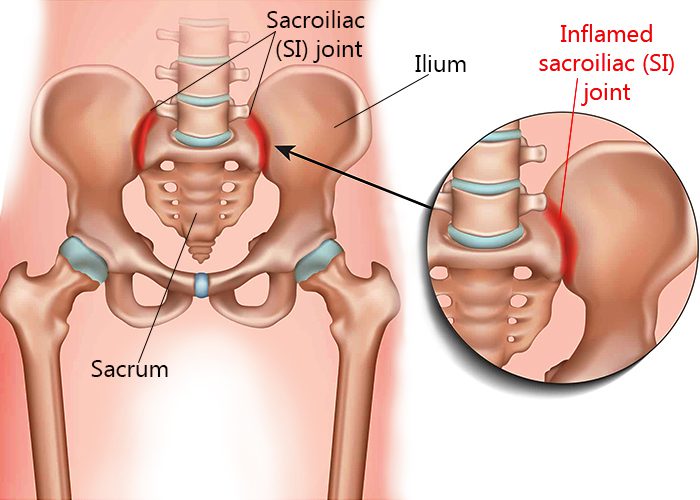 OUR LOCATIONSCall to book (212) 604-1300
OUR LOCATIONSCall to book (212) 604-1300
 OUR LOCATIONSCall to book (212) 604-1300
OUR LOCATIONSCall to book (212) 604-1300
Table of contents

Sacroiliac joint pain occurs in the lower back and buttocks area. It’s mostly likely due to inflammation of one or both of your sacroiliac (SI) joints. The sacroiliac joints are deep in your pelvis, on either side of the sacral spine, where your pelvis is joined to the sacrum. The sacrum is a triangle-shaped bone between your hip bones.
Damage to the ligaments, nerves or soft tissues of the sacroiliac joint lead to incapacitating pain that can also affect your movement. Sacrum pain feels like a sharp, stabbing sensation radiating from your hips and pelvis into your lower back. All back and hip pain should be diagnosed by a professional because of the potential for serious injury.
If you experience severe pain in your pelvic region, lower back or feet, seek a pain management doctor for advice and treatment. Dr. Amr Hosny and the expert back doctors at the state-of-the-art New York Pain Care facilities in New York City and northern New Jersey use the latest medical equipment to diagnose and treat spinal conditions.
Damage to your spine or hips can alter your life because of the debilitating pain and mobility issues that ensue. The SI joint performs critical functions as a shock absorber for the upper spine, distributing force from your lower extremities.
Symptoms of sacroiliac joint pain, which highlight the seriousness of this condition, include:
Severe sacroiliac joint pain makes it difficult to work, walk or perform ordinary life tasks. An early diagnosis by a spine specialist makes all the difference. Your pain doctors — in Midtown Manhattan, Greenwich Village and the Financial District, as well as in Bergen County, Morris County and Union County, NJ — have the skills and equipment for a correct diagnosis before starting your individualized treatment.




The injury or disease that causes inflammation of one or both sacroiliac joints can lead to sacroiliac joint pain.
Several conditions can cause sacroiliac joint pain, including:
Dr. Hosny is a board-certified, Harvard-trained, interventional spine specialist who’s best placed to treat the pain from spinal conditions. The spine specialist and the team at New York Pain Care examine your medical history and review imaging tests to determine the cause of your pain.
A number of factors increase your risk of sacroiliac joint pain.
These include:
As part of your sacroiliac joint dysfunction treatment, your spinal treatment team explains these risks to you. They advise you how to avoid complications and further pain.


Your pain management doctors create a personalized sacroiliac joint dysfunction treatment based on the diagnosis. The results of imaging tests help determine the severity of your joint damage. The objective of treatment includes pain management and restoring function to this critical joint.
Treatment options include:
After treatment, your doctor discusses prevention measures such as ergonomics in your working area, regular exercises, losing weight, proper lifting techniques and proper nutrition. If lower back pain or hip pain affects your capacity to enjoy life, contact the spine doctors at New York Pain Care.
New York Pain Care
20 Squadron Blvd, Suite 290
New City, NY 10956
(212) 242-8160






